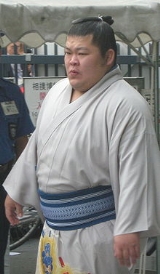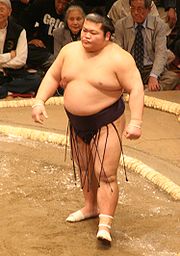
Takekaze Akira
Encyclopedia
Takekaze Akira is a professional sumo
wrestler from Akita Prefecture
, Japan
. A former amateur sumo champion, he turned professional in 2002, reaching the top division the following year. He has been a runner-up in one tournament and earned two special prizes for Fighting Spirit. His highest rank has been komusubi.
, Kitaakita District
, Takekaze practised sumo in college and was a very dominant player, having achieved the student equivalent of yokozuna after winning the Kokutai
(Japan Games) and All Japan University Championship sumo tournaments in 2001, his fourth year at Chuo University
. He made his professional debut in May 2002, joining former ozeki Kotokaze's Oguruma stable
. He was given makushita tsukedashi status and allowed to enter at the rank of makushita 15 due to his amateur achievements. He reached sekitori
level in just two tournaments, and was promoted to the top makuuchi
division in March 2003, the first wrestler from his stable to achieve this.
Takekaze had to pull out of his debut tournament in the top division due to injury and fell back to the jūryō division. However upon winning the jūryō championship in September 2003 with a 13-2 record he was promoted back to the top division. He took time to adjust to the stronger opposition in makuuchi and did not achieve a kachi-koshi or winning record above the mid maegashira ranks until May 2007. He has tended to struggle when pitted against the top ranked wrestlers and has not managed to defeat a yokozuna to date. However, in January 2008 he produced his best score in the top division, 12-3, which included a defeat of ozeki Kotooshu. He was awarded his first special prize
, for Fighting Spirit. Consequently, in the March, 2008 tournament he debuted at the komusubi rank, finally breaking into sanyaku. He is the first wrestler from his stable to make the titled ranks.
 Takekaze could manage only three wins in his komusubi debut and was demoted to maegashira 8 for the May 2008 tournament. However, an 8-7 score at maegashira 4 in March 2009, which included a defeat of ozeki Kotomitsuki, saw him climb to maegashira 2 for the May 2009 tournament. He also reached maegashira 1 in November 2009, which is his second highest ranking in his career to date. In September 2010 he finished runner-up in a tournament for the first time, and was awarded his second Fighting Spirit prize, shared with stablemate Yoshikaze.
Takekaze could manage only three wins in his komusubi debut and was demoted to maegashira 8 for the May 2008 tournament. However, an 8-7 score at maegashira 4 in March 2009, which included a defeat of ozeki Kotomitsuki, saw him climb to maegashira 2 for the May 2009 tournament. He also reached maegashira 1 in November 2009, which is his second highest ranking in his career to date. In September 2010 he finished runner-up in a tournament for the first time, and was awarded his second Fighting Spirit prize, shared with stablemate Yoshikaze.
, and usually loses if his opponents grab hold of his mawashi
or belt. As of May 2009, he had won 120 bouts by oshi-dashi or push out, but just 11 by yori-kiri or force out, which is the most popular overall technique in sumo. He also regularly employs hiki-otoshi, the pull-down,and tsuki-otoshi, the thrust over. At just 172 cm (5 ft 7½ in) he is one of the shortest men in the top division.
Sumo
is a competitive full-contact sport where a wrestler attempts to force another wrestler out of a circular ring or to touch the ground with anything other than the soles of the feet. The sport originated in Japan, the only country where it is practiced professionally...
wrestler from Akita Prefecture
Akita Prefecture
is a prefecture of Japan located in the Tōhoku Region of northern Honshu, the main island of Japan. The capital is the city of Akita.- History :The area of Akita has been created from the ancient provinces of Dewa and Mutsu....
, Japan
Japan
Japan is an island nation in East Asia. Located in the Pacific Ocean, it lies to the east of the Sea of Japan, China, North Korea, South Korea and Russia, stretching from the Sea of Okhotsk in the north to the East China Sea and Taiwan in the south...
. A former amateur sumo champion, he turned professional in 2002, reaching the top division the following year. He has been a runner-up in one tournament and earned two special prizes for Fighting Spirit. His highest rank has been komusubi.
Career
Born in MoriyoshiMoriyoshi, Akita
Moriyoshi was a town located in Kitaakita District, Akita, Japan.The city of Kitaakita was founded on March 22, 2005 from the merger of the former towns of Aikawa, Ani, Moriyoshi, and Takanosu, all from Kitaakita District....
, Kitaakita District
Kitaakita District, Akita
is a district located in Akita, Japan.As of 2003, the district has an estimated population of 3,145 and a density of 12.25 persons per km². The total area is 256.82 km².-Mergers:...
, Takekaze practised sumo in college and was a very dominant player, having achieved the student equivalent of yokozuna after winning the Kokutai
National Sports Festival of Japan
is the national premier sports event of Japan. The abbreviated name is Kokutai . The 65th National Sports Festival of Japan was held in October 2010 in Chiba Prefecture.- Emperor's Cup and Empress Cup Champions :...
(Japan Games) and All Japan University Championship sumo tournaments in 2001, his fourth year at Chuo University
Chuo University
Chuo University is a one of the Japanese leading universities. Thus it is competitive in several rankings such as shown below.-General Rankings:The university has been ranked 27th, 25th, 34th during 2008-2010 respectively in the ranking "Truly Strong Universities" by Toyo Keizai.-Research...
. He made his professional debut in May 2002, joining former ozeki Kotokaze's Oguruma stable
Oguruma Stable
is a stable of sumo wrestlers, one of the Nishonoseki group of stables. In its modern form it dates from 1987 when it was founded by Kotokaze, a former Sadogatake stable wrestler. He gives all his new recruits shikona with the suffix "kaze" , taken from his own fighting name. The first wrestler...
. He was given makushita tsukedashi status and allowed to enter at the rank of makushita 15 due to his amateur achievements. He reached sekitori
Sekitori
A sekitori is a sumo wrestler who is ranked in one of the top two professional divisions: makuuchi and juryo.Currently there are 70 rikishi in these divisions...
level in just two tournaments, and was promoted to the top makuuchi
Makuuchi
or is the top division of professional sumo. Its size is fixed at 42 wrestlers , ordered into five ranks according to their ability as defined by their performance in previous tournaments....
division in March 2003, the first wrestler from his stable to achieve this.
Takekaze had to pull out of his debut tournament in the top division due to injury and fell back to the jūryō division. However upon winning the jūryō championship in September 2003 with a 13-2 record he was promoted back to the top division. He took time to adjust to the stronger opposition in makuuchi and did not achieve a kachi-koshi or winning record above the mid maegashira ranks until May 2007. He has tended to struggle when pitted against the top ranked wrestlers and has not managed to defeat a yokozuna to date. However, in January 2008 he produced his best score in the top division, 12-3, which included a defeat of ozeki Kotooshu. He was awarded his first special prize
Sansho (Sumo)
Sanshō are the three special prizes awarded to top division sumo wrestlers for exceptional performance during a sumo honbasho or tournament. The prizes were first awarded in November 1947.-Criteria:...
, for Fighting Spirit. Consequently, in the March, 2008 tournament he debuted at the komusubi rank, finally breaking into sanyaku. He is the first wrestler from his stable to make the titled ranks.

Fighting style
Takekaze is almost entirely reliant on oshi-sumo or pushing techniquesKimarite
Kimarite are winning techniques in a sumo bout. For each bout in a Grand Sumo tournament , a sumo referee, or gyoji, will decide and announce the type of kimarite used by the winner...
, and usually loses if his opponents grab hold of his mawashi
Mawashi
In sumo, a mawashi is the belt that the rikishi wears during training or in competition. Upper ranked professional wrestlers wear a keshō-mawashi as part of the ring entry ceremony or dohyo-iri.-Mawashi:...
or belt. As of May 2009, he had won 120 bouts by oshi-dashi or push out, but just 11 by yori-kiri or force out, which is the most popular overall technique in sumo. He also regularly employs hiki-otoshi, the pull-down,and tsuki-otoshi, the thrust over. At just 172 cm (5 ft 7½ in) he is one of the shortest men in the top division.
Tournament record
See also
- Glossary of sumo termsGlossary of sumo termsThe following words are terms used in sumo wrestling in Japan. azukari : Hold. A kind of draw. After a mono-ii, the gyōji or the shimpan "holds" the result if it was too close to call...
- List of sumo tournament second division winners
- List of active sumo wrestlers

